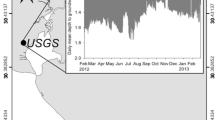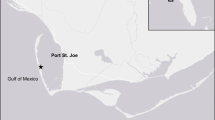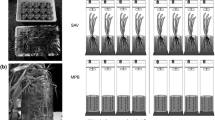Abstract
Intensive agriculture leads to increased nitrogen fluxes (mostly as nitrate, NO3 −) to aquatic ecosystems, which in turn creates ecological problems, including eutrophication and associated harmful algal blooms. These problems have focused scientific attention on understanding the controls on nitrate reduction processes such as denitrification and dissimilatory nitrate reduction to ammonium (DNRA). Our objective was to determine the effects of nutrient-tolerant bioturbating invertebrates (tubificid oligochaetes) on nitrogen cycling processes, specifically coupled nitrification–denitrification, net denitrification, DNRA, and biogeochemical fluxes (O2, NO3 −, NH4 +, CO2, N2O, and CH4) in freshwater sediments. A mesocosm experiment determined how tubificid density and increasing NO3 − concentrations (using N15 isotope tracing) interact to affect N cycling processes. At the lowest NO3 − concentration and in the absence of bioturbation, the relative importance of denitrification to DNRA was similar (i.e., 49.6 and 50.4 ± 8.1 %, respectively). Increasing NO3 − concentrations in the control cores (without fauna) stimulated denitrification, but did not enhance DNRA, which significantly altered the relative importance of denitrification compared to DNRA (94.6 vs. 5.4 ± 0.9 %, respectively). The presence of tubificid oligochaetes enhanced O2, NO3 −, NH4 + fluxes, greenhouse gas production, and N cycling processes. The relative importance of denitrification to DNRA shifted towards favoring denitrification with both the increase in NO3 − concentrations and the increase of bioturbation activity. Our study highlights that understanding the interactions between nutrient-tolerant bioturbating species and nitrate contamination is important for determining the nitrogen removal capacity of eutrophic freshwater ecosystems.





Similar content being viewed by others
References
An S, Gardner WS (2002) Dissimilatory nitrate reduction to ammonium (DNRA) as a nitrogen link, versus denitrification as a sink in a shallow estuary (Laguna Madre/Baffin Bay, Texas). Mar Ecol Prog Ser 237:41–50
APHA (American Public Health Association) (1998) Standard methods for the examination of water and waste water, 20th edn. American Public Health Association, Washington, DC
Berner RA (1980) Early diagenesis. Princeton Press, Princeton
Boudreau BP (1996) The diffusive tortuosity of fine-grained unlithified sediments. Geochim Cosmochim Acta 60:3139–3142
Boudreau BP (1997) Diagenetic models and their implementation: modeling transport and reactions in aquatic sediments. Springer, New York
Burgin AJ, Hamilton SK (2007) Have we overemphasized the role of denitrification in aquatic ecosystems? A review of nitrate removal pathways. Front Ecol Environ 5:89–96
Burgin AJ, Hamilton SK (2008) NO3 − driven SO4 2− production in freshwater ecosystems: implications for N and S cycling. Ecosystems 11:908–922
Burgin AJ, Hamilton SK, Gardner WS, McCarthy WJ (2013) Nitrate reduction, denitrification and dissimilatory nitrate reduction to ammonium in wetland sediments. In: DeLaune RD, Reddy KR, Richardson CJ, Megonigal JP (eds) Methods in biogeochemistry of wetlands, SSSA Book Series, no. 10, chapter 28, Soil Science Society of America, Inc., Madison
Casper P, Maberly SC, Hall GH, Finlay BJ (2000) Fluxes of methane and carbon dioxide from a small productive lake to the atmosphere. Biogeochemistry 49:1–19
Chapman PM (2001) Utility and relevance of aquatic oligochaetes in ecological risk assessment. Hydrobiologia 463:149–169
Chapman PM, Churchland LM, Thomson PA, Michnowsky E (1980) Heavy metal studies with oligochaetes. In: Brinkhurst RO, Look DG (eds) Aquatic oligochaetes biology. Plenum Press, New York, pp 477–502
Chatarpaul L, Robinson JB, Kaushik NK (1980) Effects of tubificid worms on denitrification and nitrification in stream sediment. Can J Fish Aquat Sci 37:656–663
David MB, Wall LG, Royer TV, Tank JL (2006) Denitrification and the nitrogen budget of a reservoir in an agricultural landscape. Ecol Appl 16:2177–2190
Eyre BD, Rysgaard S, Dalsgaard T, Christensen PB (2002) Comparison of isotope pairing and N2: Ar methods for measuring sediment denitrification—assumption, modifications, and implications. Estuaries 25:1077–1087
Findlay RH, Trexler MB, Guckert JB, White DC (1990) Laboratory study of disturbance in marine sediments: response of a microbial community. Mar Ecol Prog Ser 62:121–133
Gardner WS, Nalepa TF, Slavens DR, Laird GA (1983) Patterns and rates of nitrogen release by benthic chironomidae and oligochaeta. Can J Fish Aquat Sci 40:259–266
Gardner WS, McCarthy MJ, An SM, Sobolev D, Sell KS, Brock D (2006) Nitrogen fixation and dissimilatory nitrate reduction to ammonium (DNRA) support nitrogen dynamics in Texas estuaries. Limnol Oceanogr 51:558–568
Ghadouani A, Coggins LX (2011) Science, technology and policy for water pollution control at the watershed scale: current issues and future challenges. Phys Chem Earth A/B/C 36:335–341
Harrison J, Maranger R, Alexander R, Giblin A, Jacinthe P-A, Mayorga E, Seitzinger SP, Sobota DJ, Wollheim WM (2009) The regional and global significance of nitrogen removal in lakes and reservoirs. Biogeochemistry 93:143–157
Holmes RM, McClelland JW, Sigman DM, Fry B, Peterson BJ (1998) Measuring 15N–NH4 + in marine, estuarine and fresh waters: an adaptation of the ammonia diffusion method for samples with low ammonium concentrations. Mar Chem 60:235–243
Inwood SE, Tank JL, Bernot MJ (2007) Factors controlling sediment denitrification in Midwestern streams of varying land use. Microb Ecol 2:247–258
Kana TK, Darkangelo C, Hunt MD, Oldham JB, Bennett GE, Cornwell JC (1994) Membrane inlet mass spectrometer for rapid high-precision determination of N2, O2, and Ar in environmental water samples. Anal Chem 66:4166–4170
Kaspar HF, Tiedje JM, Firestone RB (1981) Denitrification and dissimilatory nitrate reduction to ammonium in digested sludge. Can J Microbiol 27:878–885
Kemp MJ, Dodds WK (2002) The influence of ammonium, nitrate, and dissolved oxygen concentrations on uptake, nitrification, and denitrification rates associated prairie stream substrata. Limnol Oceanogr 47:1380–1393
Knowles R (1982) Denitrification. Microbiol Rev 46:43–70
McCall PL, Fisher JB (1980) Effects of tubificid oligochaetes on physical and chemical properties of lake Erie sediments. In: Brinkhurst RO, Cook DG (eds) Aquatic oligochaete biology. Plenum Press, New York, pp 253–317
McCrackin ML, Elser JJ (2010) Atmospheric nitrogen deposition influences denitrification and nitrous oxide production in lakes. Ecology 91:528–539
Mengis M, Gächter R, Wehrli B (1997) Sources and sinks of nitrous oxide (N2O) in deep lakes. Biogeochemistry 38:281–301
Mermillod-Blondin F, Nogaro G, Datry T, Malard F, Gibert J (2005) Do tubificid worms influence the fate of organic matter and pollutants in stormwater sediments? Environ Pollut 134:57–69
NAPD, National Atmospheric Deposition Program (NRSP-3)/National Trends Network (2004) NADP Program Office, Illinois State Water Survey, Champaign, Illinois
Nielsen LP (1992) Denitrification in sediment determined from nitrogen isotope pairing. FEMS Microbiol Ecol 86:357–362
Nogaro G, Mermillod-Blondin F, Montuelle B, Boisson JC, Lafont M, Volat B, Gibert J (2007) Do tubificid worms influence organic matter processing and fate of pollutants in stormwater sediments deposited at the surface of infiltration systems? Chemosphere 70:315–328
Pelegri SP, Blackburn TH (1995) Effects of Tubifex tubifex (Oligochaeta: Tubificidae) on N-mineralization in freshwater sediments measured with 15N isotopes. Aquat Microb Ecol 9:289–294
Pelegri SP, Blackburn TH (1996) Nitrogen cycling in lake sediments bioturbated by chironomus plumonsus larvae, under different degrees of oxygenation. Hydrobiologia 325:231–238
R Development Core Team (2008) R: a language and environment for statistical computing. R Foundation for Statistical Computing, Vienna. http://www.R-project.org
Rabalais NN, Turner RE, Scavia D (2002) Beyond science into policy: Gulf of Mexico hypoxia and the Mississippi River. Bioscience 52:129–142
Reichardt W (1988) Impact of bioturbation by Arenicola marina on microbiological parameters in intertidal sediments. Mar Ecol Prog Ser 44:149–158
Risgaard-Petersen N, Rysgaard S (1995) Nitrate reduction in sediments and water logged soil measured by 15N techniques. In: Alef K, Nannipieri P (eds) Methods in applied soil microbiology. Academic Press, London, pp 287–310
Seitzinger SP, Gardner WS, Spratt AK (1991) The effect of salinity on ammonium sorption in aquatic sediments: implications for benthic nutrient recycling. Estuaries 14:167–174
Seitzinger S, Harrison JA, Bohlke JK, Bouwman AF, Lowrance R, Peterson B, Tobias C, Van Drecht G (2006) Denitrification across landscapes and waterscapes: a synthesis. Ecol Appl 16:2064–2090
Smith VH, Schindler DW (2009) Eutrophication science: where do we go from here? Trends Ecol Evol 24:201–207
Smith VH, Tilman GD, Nekola JC (1999) Eutrophication: impacts of excess nutrient inputs on freshwater, marine, and terrestrial ecosystems. Environ Pollut 100:179–196
Steingruber SM, Friedrich J, Gächter R, Wehrli B (2001) Measurement of denitrification in sediments with the 15N isotope pairing technique. Appl Environ Microb 67:3771–3778
Stocum ET, Plante CJ (2006) The effect of artificial defaunation on bacterial assemblages of intertidal sediments. J Exp Mar Biol Ecol 337:147–158
Svensson JM, Leonardson L (1996) Effect of bioturbation by tube-dwelling chironomid larvae on oxygen uptake and denitrification in eutrophic lake sediments. Freshw Biol 35:289–300
Svensson JM, Enrich-Prast A, Leonardson L (2001) Nitrification and denitrification in a eutrophic lake sediment bioturbated by oligochaetes. Aquat Microb Ecol 23:177–186
Tiedje JM (1988) Ecology of denitrification and dissimilatory nitrate reduction to ammonium. In: Zehnder AJB (ed) Biology of anaerobic microorganisms. Wiley, New York
Weatherburn MW (1967) Phenol–hypochlorite reaction for determination of ammonia. Anal Chem 39:971–974
Acknowledgments
We thank the following individuals who assisted with either sample collection or analyses: Melissa Tabatchnick, Avani Naik, Matt Konkler, Erin Cull, Melanie Stall, Valerie Schoepfer, and Sarah Harvey. We also thank Marshall Otter at MBL’s Stable Isotope Laboratory (Woods Hole, MA) for analyzing 15N samples. We also thank three anonymous referees for their valuable comments to the manuscript and their constructive suggestions.
Author information
Authors and Affiliations
Corresponding author
Rights and permissions
About this article
Cite this article
Nogaro, G., Burgin, A.J. Influence of bioturbation on denitrification and dissimilatory nitrate reduction to ammonium (DNRA) in freshwater sediments. Biogeochemistry 120, 279–294 (2014). https://doi.org/10.1007/s10533-014-9995-9
Received:
Accepted:
Published:
Issue Date:
DOI: https://doi.org/10.1007/s10533-014-9995-9




